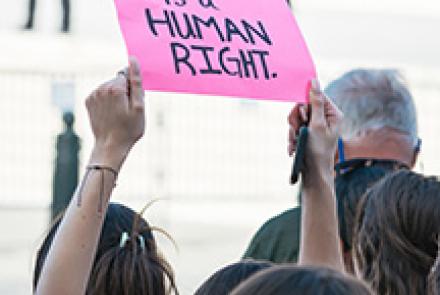Annotated Bibliography: Women's Rights and Legal Representation
Agarwal, B. (1994). Gender and command over property: A critical gap in economic analysis and policy in South Asia. World Development, 22(10), 1455-1478.
This paper focuses on a much-neglected issue: the links between gender inequities and command over property. It outlines why in rural South Asia, where arable land is the most important form of property, any significant improvement in women’s economic and social situation is crucially tied to their having independent land rights. Better employment opportunities can complement but not substitute for land. But despite progressive legislation few South Asian women own land; even fewer effectively control any. Why? A complex range of factors - social, administrative, and ideological - are found to underlie the persistent gap between women’s legal rights and their actual ownership of land, and between ownership and control. The necessity of collective action by women for overcoming these obstacles and the aspects needing a specific focus for policy and action are also discussed.
Agarwal, B. (1995). Gender, Property, and Land Rights: Bridging a critical gap in economic analysis and policy. In S. Feiner, E. Kuiper, N. Ott, J. Sap, & Z. Tzannatos (Eds.), Out of the Margin (pp. 202-223): Routledge.
Economic analyses and policies concerning women have long been preoccupied with employment, to the neglect of a crucial determinant of women’s situation, namely the gender gap in command over property. This is especially (but not only) true in analyses relating to South Asia. It is argued here that the gender gap in the ownership and control of property is the single most critical contributor to the gender gap in economic well-being, social status and empowerment. In primarily rural economies such as those of South Asia the most important form of property is arable land. A struggle for gender equality in command over landed property will therefore need to occupy center stage in South Asian women’s struggle for egalitarian gender relations. The discussion below is divided into five sections. Section one examines the conceptual links between gender, property, and land rights. Section two elaborates upon why it is important for rural women to have independent rights in land, especially for women’s empowerment. Section three looks at gender relations historically in those South Asian communities in which women traditionally enjoyed rights in land. Section four identifies the obstacles women face in realizing effective land rights in most parts of South Asia today, and illustrates how women’s command over economic resources is crucially mediated by non-economic factors. Finally, section five highlights some aspects of the interventions needed for change.
Deininger, K., Goyal, A., & Nagarajan, H. (2013). Women's inheritance rights and intergenerational transmission of resources in India. Journal of Human Resources, 48(1), 114-141.
We use inheritance patterns over three generations of individuals to assess the impact of changes in the Hindu Succession Act that grant daughters equal coparcenary birth rights in joint family property that were denied to daughters in the past. We show that the amendment significantly increased daughters’ likelihood to inherit land, but that even after the amendment, substantial bias persists. Our results also indicate a robust increase in educational attainment of daughters, suggesting an alternative channel of wealth transfer.
Doss, C., Truong, M., Nabanoga, G., & Namaalwa, J. (2012). Women, marriage and asset inheritance in Uganda. Development Policy Review, 30(5), 597-616.
Using a unique dataset which collected individual-level asset ownership data and women’s life histories regarding assets, this article examines the relationships between inheritance, marriage and asset ownership in Uganda. Land is the most important asset in rural Uganda. The majority of couples (both married and those in consensual unions) report owning land jointly. Men who report owning a parcel of land are much more likely than women to say they inherited the land. Inheritance is not an important means of acquisition of other assets, including livestock, business assets, financial assets and consumer durables. These items are acquired through purchase, by both men and women.
Estudillo, J., Quisumbing, A., & Otsuka, K. (2001). Gender differences in land inheritance, schooling and lifetime income: evidence from the rural Philippines. Journal of Development Studies, 37(4), 23-48.
This article examines the difference in lifetime incomes arising from parental preferences in the allocation of land inheritance and investments in schooling between sons and daughters in the rural Philippines. Sons are preferred with respect to land inheritance, receiving 0.15 additional hectares of land, while daughters are treated more favourably in schooling investments, receiving 1.5 more years of schooling. However, differences in both current and life-cycle incomes between sons and daughters are insignificant. This suggests that Filipino parents allocate intergenerational transfers to equalise incomes among their children, without sacrificing efficiency.
Makhado, R., & Pelizzo, R. (2016). Looking at Women Rights to Land in Africa: A Feminist Perspective? African Politics and Policies, 2(1).
This review paper advocate for women rights to land because land is central for effective implementation of rural development and land reform initiatives. This is critical because women constitute the majority of people in rural areas and represent the highest number of people working on the land mainly for subsistence purposes. However, the rights of women to access and own land in most African countries is still not proportional to what men enjoy. Customary laws and cultural practices are used to systematically deny women rights to access and own land. Eliminating discrimination in land is essential in order to redress the impoverishment of millions of women in the African continent. This review paper therefore advocate for equal rights in the allocation of land. It also provides insights and discussion on gender-based land allocation.
Swamy, A., Knack, S., Lee, Y., & Azfar, O. (2001). Gender and corruption. Journal of development economics, 64(1), 25-55.
Using several independent data sets, we investigate the relationship between gender and corruption. We show using micro data that women are less involved in bribery, and are less likely to condone bribe taking. Cross-country data show that corruption is less severe where women hold a larger share of parliamentary seats and senior positions in the government bureaucracy, and comprise a larger share of the labor force.
Tinker, I. (2004). Quotas for women in elected legislatures: do they really empower women? Paper presented at the Women's Studies International Forum.
The demand for 30% reservations for women in electoral bodies has escalated in the last decade and has produced significant increases in women legislators in many countries. Those campaigning for quotas anticipated a change in government policies and priorities and an increased influence of women in decision-making. Such a shift in power depends both on the types of party systems and of electoral systems, issues widely overlooked. Utilizing proportional representation (PR) with a fixed party list system will certainly increase the number of women elected; but women selected must be party loyalists. Studies suggest their impact on policy is limited. Reservations in countries using the single-member constituency system require legal change. Women leaders of civil society organizations are more likely to win elections under the single- constituency system and thus have greater influence on policy. Many obstacles remain for women to be effective in all these male-dominated chambers.




